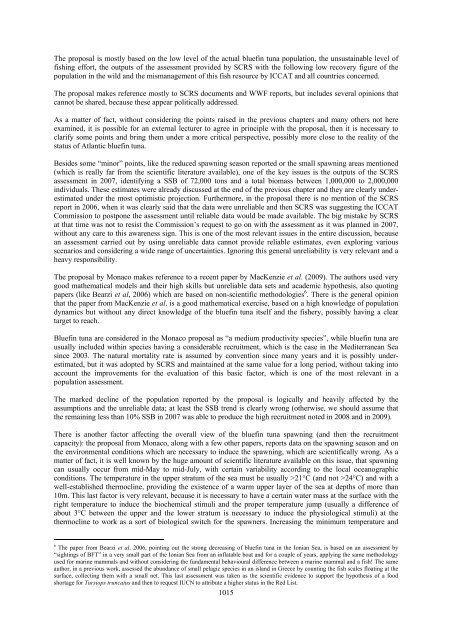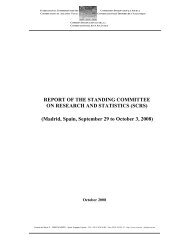SCRS/2009/189 - iccat
SCRS/2009/189 - iccat
SCRS/2009/189 - iccat
You also want an ePaper? Increase the reach of your titles
YUMPU automatically turns print PDFs into web optimized ePapers that Google loves.
The proposal is mostly based on the low level of the actual bluefin tuna population, the unsustainable level of<br />
fishing effort, the outputs of the assessment provided by <strong>SCRS</strong> with the following low recovery figure of the<br />
population in the wild and the mismanagement of this fish resource by ICCAT and all countries concerned.<br />
The proposal makes reference mostly to <strong>SCRS</strong> documents and WWF reports, but includes several opinions that<br />
cannot be shared, because these appear politically addressed.<br />
As a matter of fact, without considering the points raised in the previous chapters and many others not here<br />
examined, it is possible for an external lecturer to agree in principle with the proposal, then it is necessary to<br />
clarify some points and bring them under a more critical perspective, possibly more close to the reality of the<br />
status of Atlantic bluefin tuna.<br />
Besides some “minor” points, like the reduced spawning season reported or the small spawning areas mentioned<br />
(which is really far from the scientific literature available), one of the key issues is the outputs of the <strong>SCRS</strong><br />
assessment in 2007, identifying a SSB of 72,000 tons and a total biomass between 1,000,000 to 2,000,000<br />
individuals. These estimates were already discussed at the end of the previous chapter and they are clearly underestimated<br />
under the most optimistic projection. Furthermore, in the proposal there is no mention of the <strong>SCRS</strong><br />
report in 2006, when it was clearly said that the data were unreliable and then <strong>SCRS</strong> was suggesting the ICCAT<br />
Commission to postpone the assessment until reliable data would be made available. The big mistake by <strong>SCRS</strong><br />
at that time was not to resist the Commission’s request to go on with the assessment as it was planned in 2007,<br />
without any care to this awareness sign. This is one of the most relevant issues in the entire discussion, because<br />
an assessment carried out by using unreliable data cannot provide reliable estimates, even exploring various<br />
scenarios and considering a wide range of uncertainties. Ignoring this general unreliability is very relevant and a<br />
heavy responsibility.<br />
The proposal by Monaco makes reference to a recent paper by MacKenzie et al. (<strong>2009</strong>). The authors used very<br />
good mathematical models and their high skills but unreliable data sets and academic hypothesis, also quoting<br />
papers (like Bearzi et al, 2006) which are based on non-scientific methodologies 6 . There is the general opinion<br />
that the paper from MacKenzie et al. is a good mathematical exercise, based on a high knowledge of population<br />
dynamics but without any direct knowledge of the bluefin tuna itself and the fishery, possibly having a clear<br />
target to reach.<br />
Bluefin tuna are considered in the Monaco proposal as “a medium productivity species”, while bluefin tuna are<br />
usually included within species having a considerable recruitment, which is the case in the Mediterranean Sea<br />
since 2003. The natural mortality rate is assumed by convention since many years and it is possibly underestimated,<br />
but it was adopted by <strong>SCRS</strong> and maintained at the same value for a long period, without taking into<br />
account the improvements for the evaluation of this basic factor, which is one of the most relevant in a<br />
population assessment.<br />
The marked decline of the population reported by the proposal is logically and heavily affected by the<br />
assumptions and the unreliable data; at least the SSB trend is clearly wrong (otherwise, we should assume that<br />
the remaining less than 10% SSB in 2007 was able to produce the high recruitment noted in 2008 and in <strong>2009</strong>).<br />
There is another factor affecting the overall view of the bluefin tuna spawning (and then the recruitment<br />
capacity): the proposal from Monaco, along with a few other papers, reports data on the spawning season and on<br />
the environmental conditions which are necessary to induce the spawning, which are scientifically wrong. As a<br />
matter of fact, it is well known by the huge amount of scientific literature available on this issue, that spawning<br />
can usually occur from mid-May to mid-July, with certain variability according to the local oceanographic<br />
conditions. The temperature in the upper stratum of the sea must be usually >21°C (and not >24°C) and with a<br />
well-established thermocline, providing the existence of a warm upper layer of the sea at depths of more than<br />
10m. This last factor is very relevant, because it is necessary to have a certain water mass at the surface with the<br />
right temperature to induce the biochemical stimuli and the proper temperature jump (usually a difference of<br />
about 3°C between the upper and the lower stratum is necessary to induce the physiological stimuli) at the<br />
thermocline to work as a sort of biological switch for the spawners. Increasing the minimum temperature and<br />
6 The paper from Bearzi et al. 2006, pointing out the strong decreasing of bluefin tuna in the Ionian Sea, is based on an assessment by<br />
“sightings of BFT” in a very small part of the Ionian Sea from an inflatable boat and for a couple of years, applying the same methodology<br />
used for marine mammals and without considering the fundamental behavioural difference between a marine mammal and a fish! The same<br />
author, in a previous work, assessed the abundance of small pelagic species in an island in Greece by counting the fish scales floating at the<br />
surface, collecting them with a small net. This last assessment was taken as the scientific evidence to support the hypothesis of a food<br />
shortage for Tursiops truncatus and then to request IUCN to attribute a higher status in the Red List.<br />
1015

















